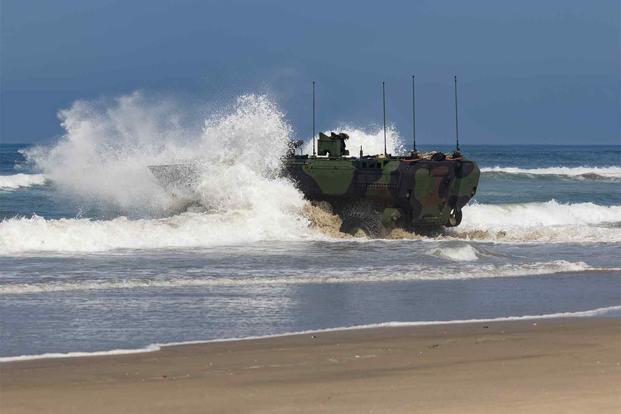Two years after a deadly mishap caused the death of eight Marines and a Navy corpsman when their amphibious vehicle sank off the coast of California's San Clemente Island, pushing the Marine Corps to accelerate the launch of its replacement vehicle -- which itself suffered several non-deadly accidents, the service says it has graduated its first batch of troops under a new training program intended to prevent future problems.
Officers in charge of the program told reporters that so far they have retrained 59 Marines to safely operate the new Amphibious Combat Vehicle, or ACV.
Since it was rushed into service in 2020, the ACV has experienced a string of safety mishaps and issues that have left it either completely sidelined or unable to operate in certain conditions, incidents that the Corps has tied to problematic training.
Read Next: Veterans in Congress Press for Bowe Bergdahl to Be Retried After Sentenced Was Dismissed
In 2021, there was a stand-down over an issue with the ACV's towing mechanism. Then, in the summer of 2022, one of the vehicles tipped onto its side in a surf zone, and another became disabled at Camp Pendleton in California.
Neither of those incidents resulted in deaths, but the Marine Corps stopped using the vehicle in the water after the two accidents.
The service let the craft get back in the water in September, only to have another ACV flip off the coast of Camp Pendleton in October. The Marine Corps subsequently reinstated its surf zone ban.
Col. Howard Hall, who oversaw some of the Corps' efforts to get the ACV back into the surf, told reporters that a study of ACV mishaps revealed that one major issue was operators were trying to run the new craft, and trainers were instructing troops to use the new vehicles, like the older Amphibious Assault Vehicle (AAV).
"The changes to the [technical and training manuals] were happening faster than the training institution could adapt," Hall told reporters as part of a roundtable Friday. "It's a different vehicle that operates differently; it gives the operator different subconscious cues."
Hall said that the Marine Corps realized in late 2022 that a rethink on training was necessary.
The result was a small team "comprised of subject-matter experts from across all of the assault amphibian community" that Hall proudly noted was "17 Marines -- mostly sergeants" -- who set out to "define what right looks like in terms of training."
The revamped regimen was announced in April and, according to materials provided by the Corps on Friday, the first instructors for the retraining effort, dubbed the Transition Training Unit (TTU), were certified in May. The first operator graduates came in June.
The unit will ultimately retrain all the Marines who run and maintain the ACV by next fall through either a 15-day operator course or a five-day maintainer certification course.
At the same time, the Marine Corps has realized that it doesn't have enough instructors for the vehicles and is trying to fix the problem.
"By this August, we will have received a 30% increase in the number of instructors and support staff Marines," Col. Benjamin Venning, commander of the Assault Amphibian School, told reporters.
Venning also explained that the Marine Corps is looking to write a standard set of procedures for the ACV called the Assault Amphibian Training and Operating Procedures Standardization manual, or AATOPS, that models itself on the legendary Naval Air Training and Operating Procedures Standardization, or NATOPS.
NATOPS was introduced by the Navy in 1961 and is credited with making naval aviation significantly safer and dramatically reducing the number of mishaps.
Lt. Col. Frederick Monday, the man who is overseeing the TTU, said that "over 100 ... splashes" -- going out into the ocean in an ACV and coming back in -- have been safely done as part of the training and certification efforts as a sign that the new efforts are working.
However, the Corps is still not ready to say when the ACV will leave the training ground and deploy with Marines.
"We're working to ensure we've set the proper conditions, to include making sure our training is appropriate, before we speculate on future deployment decisions," Marine Corps spokesman Capt. Ryan Bruce told Marine Corps Times on Friday.
-- Konstantin Toropin can be reached at konstantin.toropin@military.com. Follow him on Twitter @ktoropin.
Related: The Marines' Amphibious Craft Isn't Allowed in the Surf. The Corps Hopes New Training Will Fix That.












